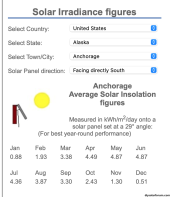GabeAteU
New Member
I am currently budgeting and researching charge controllers for a new system. I have zero experience and therefore I don’t know what I should be looking for. I will be in alaska and therefore a cold climate with snow 2/3 of the year for this reason I chose bifacial solar panels. The biggest energy expense will be my high end computer which uses about 3.5kwh including the monitor and other peripherals. I need the computer for remote work so it is a non-negotiable The next biggest energy expense is my Starlink which will use about 1.5kwh per day. After that my energy use is very minimal using just lights, tool battery charging and the occasional water pump. I intend to use just over 6kwh per day. I will be fully offgrid without the option to tap into the grid. I will however have a diesel generator that I could use though I want to keep this at a very minimum(maybe a few hours a month in the winter). I feel fairly confident in most of the numbers but I am not certain of anything.
My biggest question is on charge controllers. Information online about brands is hard to come by and it seems like renogy is the go to brand. I am on a budget but if its going to break in a year or so I dont want to risk it. What are the viable option I have? Are LiFePo4 batteries my only option in that climate or could something else work as well?
These are the general numbers for the system I am designing(nothing is set in stone and I am open to all opinions):
12,000w 24V Batteries (Unsure on brand or specifics)
4x550w Renogy Bifacial Solar Panels
2000w Renogy Inverter
Charge Controller 100 amp
Thank you all for any opinions or advice : )
My biggest question is on charge controllers. Information online about brands is hard to come by and it seems like renogy is the go to brand. I am on a budget but if its going to break in a year or so I dont want to risk it. What are the viable option I have? Are LiFePo4 batteries my only option in that climate or could something else work as well?
These are the general numbers for the system I am designing(nothing is set in stone and I am open to all opinions):
12,000w 24V Batteries (Unsure on brand or specifics)
4x550w Renogy Bifacial Solar Panels
2000w Renogy Inverter
Charge Controller 100 amp
Thank you all for any opinions or advice : )



